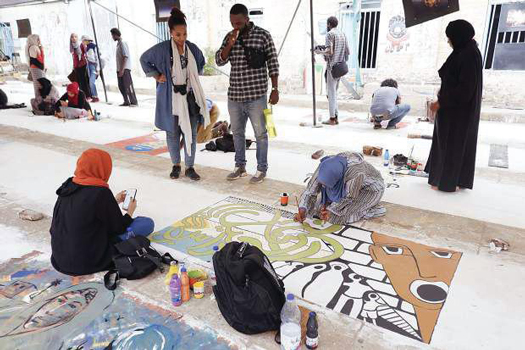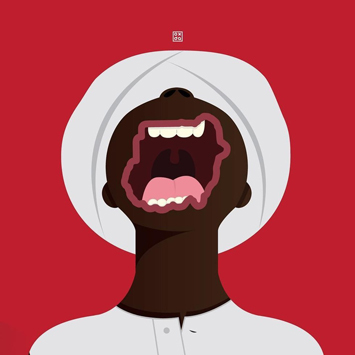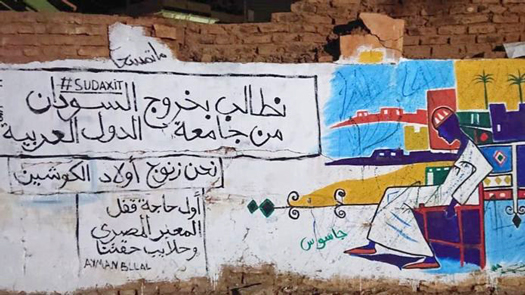Art, activism and change in Sudan
By Jehron Muhammad | Last updated: Sep 5, 2019 - 9:07:15 PMWhat's your opinion on this article?

|
Sudan’s military council and the main opposition coalition signed a power sharing agreement that is supposed to pave the way to a transition to civilian rule.

|
Under the August agreement, according to Al Jazeera, a military leader will head an 11-member council for the first 21 months, followed by a civilian leader for the next 18 months. This new government will be headed by Abdalla Hamdok, an economist, while the overall power is split between the military, with Lt. Gen. Abdel Fattah al-Burhan at the helm, along with civilian leaders. The military will also control the defense and interior ministries, which account for a large part of national spending.
But the initial uprising that sprang from the streets of Sudan, which appeared as spontaneous protest, blossomed into a massive peaceful uprising that has used art to help capture and inspire this moment in time. Though the uprising was peaceful it suffered nearly 1,000 casualties, with nearly 200 dead, resulting from the intervention of the Rapid Support Force.
According to Abdel Latif Dahir, the movement to use art to support change harkens back to the modernist art of The Khartoum School that developed in post-independence Sudan in 1960. By using visual art in activism, younger generations are continuing “that memory and legacy of standing up against totalitarian governments and military regimes,” says art historian and the director of the Institute of Comparative Modernities at Cornell University Salah Hassan.
Speaking in July in Quartz Africa in a piece titled: “Sudan’s street protests have inspired another revolution—in art,” Dahir, who holds a master’s degree in political journalism, wrote that since the uprising “murals, paintings, and graphic art have sprung across the nation: agitating peace, extolling the place of demonstrators and martyrs, exhorting the world to stand up for the Sudanese people, and imagining a better future. Besides painting, free books were distributed at the protest sites in Khartoum, drawing tents set up for children, and music concerts held that drew tens of thousands of people.”
As noted poet, freelance writer and co-founder of Nas With Notepads, a monthly poetry/spoken word, literary arts events forum in Khartoum, Sara Elhassan wrote in February in OkayAfrica, “Thirty years under the rule of Omar El-Bashir and his self-dubbed ‘Savior’ regime have led to acute brain drain in every discipline, and a complete disintegration of the arts.”
But, in a recent interview Galal Yousif observed, “No revolution exists absent of art. From the creation of protest songs to iconic photographs, artists will always find themselves amplifying the cries of the people. Such has been the case in Sudan throughout the uprising. Where the people are, so is the art.”
Yousif, a Sudanese visual artist, who was a part of the protest movement, added, “For a long time, more than 30 years now, artists were the first people to get in tough fights with the old system. It’s not only painters; I mean all arts—music, art, and theater—and [the government] worked hard to destroy the arts in the community, even in the schools. They made Islam the reason, but for sure that’s not the real Islam. We know the real reason is that artists are the ghosts for them. Artists tell the real story. Artists can raise awareness. Artists can see what people do not see. Artists are on the right side for peace, and love, and rights for the people.”

Cry of Home by Abu 'Obayda Mohamed
|
Two artists, biological sisters Enas and Alaa Satir, have used drawing to highlight the uprising and the unequaled participation of women in the protest movement. Enas and Alaa are based in Toronto and Khartoum respectively. While their content and style might differ, they’ve shared a mutual position at the helm of Sudan’s protest movement.
During a recent interview for Shado Magazine they shared their diverse perspectives on their artistic expressions. Enas, in part discussing illustrations or drawings over the written word, said, “When you draw or illustrate something, the eye will catch it faster than a written word. In an article, you can take your time and explain things ... but the artwork is what’s gonna stick to your mind, and it’s more intriguing to people–they may want to know the meaning behind it, or the motivation behind it. Thankfully, art still holds a certain status in our communities; it is valued and appreciated, therefore it’s more widely circulated.”
Alaa, who graduated as an architect, became what many saw as one of the most important faces of the Sudanese uprising, captured in photos and paintings in queenly Nubian attire. “Women,” she said were the motivation behind her work.
“To see them on the frontline of these protests—it was inspiring, but not surprising at all, because I believe that as women we are born to fight. It’s in our blood: we have been in this battle for freedom and equality for a very long time now, and when you see a regime that has been alive and well for 30 years that has hurt women the most, that has oppressed women the most, and people are out there trying to take it down. It’s not surprising to see that most of the crowds out there are women. It’s also a reminder that we’re not only trying to take a political regime down—we’re also trying to take a social system down with it; the ideas that we adopted from that regime, that were there to bring us down as women. So our fight for equality and freedom started way before the uprising, and it was important to me to remind people of that. It was also important to document the uprising from a woman’s perspective, since we are the casualties of that regime. We were the people who were harmed the most; we were the people who were harassed the most,” she said.
In a commentary titled “We used our art to fight. Now we need it to heal us,” Sudanese cartoonist and social and political satirist Khalid Albaith encouraged artists to “prepare for the next stage … Our art needs to address our trauma, and push new conversations about how to heal as a society before we start planning we need to prepare for the next stage of the fight: our emotional health. Our art needs to address our trauma, and push new conversations about how to heal as a society before we start planning our next … (move).”
Follow @jehronmuhammad on Twitter.
INSIDE STORIES AND REVIEWS
-
-
About Harriett ... and the Negro Hollywood Road Show
By Rabiah Muhammad, Guest Columnist » Full Story -
Skepticism greets Jay-Z, NFL talk of inspiring change
By Bryan 18X Crawford and Richard B. Muhammad The Final Call Newspaper @TheFinalCall » Full Story -
The painful problem of Black girls and suicide
By Charlene Muhammad -National Correspondent- » Full Story -
Exploitation of Innocence - Report: Perceptions, policies hurting Black girls
By Charlene Muhammad -National Correspondent- » Full Story -
Big Ballin: Big ideas fuel a father’s Big Baller Brand and brash business sense
By Bryan Crawford -Contributing Writer- » Full Story







 Click Here Stay Connected!
Click Here Stay Connected!








